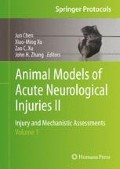Abstract
The chronic cranial window model offers the possibility of a direct in vivo assessment of the cortical surface and pial vasculature in multiple physiological and pathological CNS states. Within the last years, attention has been paid to inflammatory and microvascular changes after acute subarachnoid haemorrhage (aSAH). In combination with different assessment and recording methods, the chronic cranial window is a powerful tool to study a variety of functional and structural values in vivo with a high temporal and spatial resolution. This chapter comprises details about the technical procedure and standard as well as alternative assessment modalities, which can be used in combination with the chronic cranial window model for in vivo analyses.
Access this chapter
Tax calculation will be finalised at checkout
Purchases are for personal use only
References
Funk W, Endrich B, Messmer K (1986) A novel method for follow-up studies of the microcirculation in non-malignant tissue implants. Res Exp Med (Berl) 186(4):259–270
Menger MD et al (1988) Quantitative analysis of microcirculatory disorders after prolonged ischemia in skeletal muscle. Therapeutic effects of prophylactic isovolemic hemodilution. Res Exp Med (Berl) 188(3):151–165
Menger MD et al (1990) A novel technique for studies on the microvasculature of transplanted islets of Langerhans in vivo. Int J Microcirc Clin Exp 9(1):103–117
Menger MD, Hammersen F, Messmer K (1992) In vivo assessment of neovascularization and incorporation of prosthetic vascular biografts. Thorac Cardiovasc Surg 40(1):19–25
Lehr HA et al (1993) Dorsal skinfold chamber technique for intravital microscopy in nude mice. Am J Pathol 143(4):1055–1062
Lehr HA et al (1994) P-selectin mediates the interaction of circulating leukocytes with platelets and microvascular endothelium in response to oxidized lipoprotein in vivo. Lab Invest 71(3):380–386
Vajkoczy P et al (1995) Angiogenesis and vascularization of murine pancreatic islet isografts. Transplantation 60(2):123–127
Levasseur JE et al (1975) Detailed description of a cranial window technique for acute and chronic experiments. Stroke 6(3): 308–317
Duckrow RB et al (1981) Oxidative metabolic activity of cerebral cortex after fluid-percussion head injury in the cat. J Neurosurg 54(5):607–614
Clark JF, Reilly M, Sharp FR (2002) Oxidation of bilirubin produces compounds that cause prolonged vasospasm of rat cerebral vessels: a contributor to subarachnoid hemorrhage-induced vasospasm. J Cereb Blood Flow Metab 22(4):472–478
Manegold PC et al (2003) Platelet-endothelial interaction in tumor angiogenesis and microcirculation. Blood 101(5):1970–1976
Raymond SB et al (2007) Multiphoton imaging of ultrasound/Optison mediated cerebrovascular effects in vivo. J Cereb Blood Flow Metab 27(2):393–403
Author information
Authors and Affiliations
Corresponding author
Editor information
Editors and Affiliations
Rights and permissions
Copyright information
© 2012 Springer Science+Business Media, LLC
About this protocol
Cite this protocol
Schneider, U.C., Atangana, E.N., Vajkoczy, P. (2012). Cranial Window Assessments in Experimental aSAH in Mice. In: Chen, J., Xu, XM., Xu, Z., Zhang, J. (eds) Animal Models of Acute Neurological Injuries II. Springer Protocols Handbooks. Humana Press, Totowa, NJ. https://doi.org/10.1007/978-1-61779-576-3_40
Download citation
DOI: https://doi.org/10.1007/978-1-61779-576-3_40
Published:
Publisher Name: Humana Press, Totowa, NJ
Print ISBN: 978-1-61779-575-6
Online ISBN: 978-1-61779-576-3
eBook Packages: Springer Protocols

